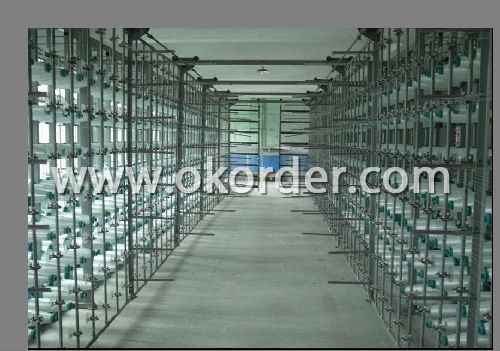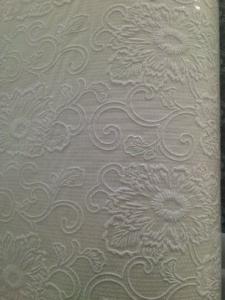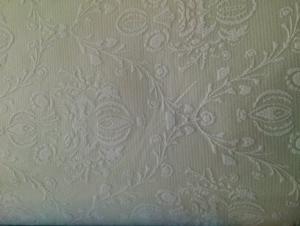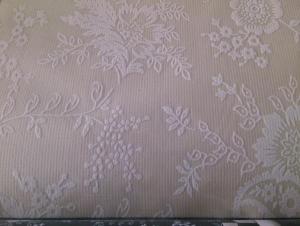Fiberglass Wallcovering Cloth - 100g/m2
- Loading Port:
- China Main Port
- Payment Terms:
- TT or LC
- Min Order Qty:
- 10000M2 m²
- Supply Capability:
- 1000000square meter/month m²/month
OKorder Service Pledge
OKorder Financial Service
You Might Also Like
Product Description of Fiberglass Wallcovering:
Fiberglass wallcovering cloth, that combines the versatility of paint, from latex to epoxy, with the strength and benefits of woven fiberglass textile
yarns to meet the most demanding wall finish requirements. Fiberglass textile yarns, as a kind of natural materials, are woven into various textures
and patterns and then treated with a natural starch binder for dimensional stability during the hanging process.
Advantages of Fiberglass Wallcovering:
* Environment Friendly
* Flame Retardant
* Air Permeability
* Shock Resistance
* Waterproofing
* Anti-corrosion
* Abundant Colors & patterns
Application of Fiberglass Wallcovering:
As a high-tech indoor decorating material, fiberglass wallcovering cloth is widely used in resident homes, offices and shops and even cinemas, t
heatres, hotels and hospital facilities, air ports, office buildings, shopping centers and schools
Externals picture of Fiberglass Wallcovering :


Packaging of Fiberglass Wallcovering :



Production of Fiberglass Wallcovering:

- Q: Can fiberglass wallcovering cloth be used on uneven surfaces?
- Yes, fiberglass wallcovering cloth can be used on uneven surfaces. Its flexibility and ability to conform to different shapes makes it suitable for application on uneven or textured walls.
- Q: Can fiberglass wallcovering cloth be used in conjunction with custom architectural elements or features?
- Yes, fiberglass wallcovering cloth can be used in conjunction with custom architectural elements or features. Its versatile nature allows it to be easily applied and molded to fit various shapes and designs, making it an ideal choice for incorporating with unique architectural elements. Additionally, fiberglass cloth offers durability, strength, and resistance to wear and tear, making it suitable for long-term use alongside custom architectural features.
- Q: Is fiberglass wallcovering cloth resistant to fading?
- Yes, fiberglass wallcovering cloth is resistant to fading. Fiberglass is known for its exceptional durability and resistance to various environmental factors, including fading. Its inherent properties make it resistant to UV rays, which are the main cause of fading in many materials. Therefore, fiberglass wallcovering cloth is an excellent choice for spaces that receive a lot of natural light or are exposed to direct sunlight, as it will maintain its color and appearance for a longer period of time compared to other materials.
- Q: Can fiberglass wallcovering cloth be used in exterior cladding systems?
- Exterior cladding systems can indeed make use of fiberglass wallcovering cloth. Fiberglass is a highly durable and flexible material that is often employed in construction due to its resilience and ability to withstand the elements. When utilized as a wallcovering cloth, it can offer extra reinforcement and safeguard the exterior cladding system. Its lightweight nature facilitates easy installation, and it can be applied to various surfaces like wood, concrete, or metal. By preventing cracks, improving resistance to impact and moisture, and providing a sleek and uniform surface for paint or other finishes, fiberglass wallcovering cloth can augment the cladding system's durability and longevity. Nevertheless, it is crucial to select a fiberglass wallcovering cloth that is specifically designed for exterior use and is compatible with the chosen cladding system. Consulting with a professional or the manufacturer will aid in determining the most suitable type and application method for the particular project requirements.
- Q: Can fiberglass wallcovering cloth be used in wet areas such as bathrooms?
- Indeed, wet areas like bathrooms can make effective use of fiberglass wallcovering cloth. Fiberglass possesses exceptional water-resistant attributes, rendering it a fitting selection for spaces susceptible to dampness and humidity. Its remarkable durability enables it to endure water exposure without distorting, flaking, or deteriorating. By employing fiberglass wallcovering cloth, one can establish a safeguarding shield that shields the underlying walls from moisture-induced harm. Moreover, its resistance to mold and mildew renders it a pragmatic choice for bathrooms, which are often exposed to high levels of moisture.
- Q: How easy is it to clean fiberglass wallcovering cloth?
- Fiberglass wallcovering cloth can be cleaned with ease. Its smooth surface prevents staining and enables effortless elimination of dirt and grime. Routine cleaning involves wiping the surface with a damp cloth or employing a gentle detergent and water mixture. For more stubborn stains, a soft bristle brush may be gently used to scrub the affected area. It is crucial to refrain from utilizing harsh chemicals or abrasive cleansers, as they have the potential to harm the fiberglass material. In summary, fiberglass wallcovering cloth is a conveniently low-maintenance and simple-to-clean choice for indoor walls.
- Q: Fiberglass (sea cloth) shortcomings
- Fiberglass itself is white, to customize color in the above brush paint, can change color, each brush paint 2-3 times. Ten service life is at least 15 years.
- Q: Can fiberglass wallcovering cloth be used in retail or commercial office spaces?
- Fiberglass wallcovering cloth is an excellent option for retail or commercial office spaces. This material is both durable and versatile, making it perfect for areas with high foot traffic. It is resistant to wear and tear and can withstand heavy use, making it ideal for commercial spaces where customers or employees are constantly coming and going. Furthermore, fiberglass wallcovering cloth has the added benefit of being fire-resistant, which is crucial for safety in commercial buildings. It is also available in a wide range of colors and patterns, allowing for customization and the creation of a professional and attractive environment. All in all, fiberglass wallcovering cloth is a great choice for retail or commercial office spaces due to its durability, fire resistance, and aesthetic appeal.
- Q: Is fiberglass wallcovering cloth waterproof?
- No, fiberglass wallcovering cloth is not inherently waterproof. While it is durable and resistant to moisture, it is not designed to be completely waterproof. However, fiberglass wallcovering cloth can provide some level of water resistance and can withstand occasional splashes or humidity. It is important to note that the water resistance of fiberglass wallcovering cloth may vary depending on the specific product and its installation method. If complete waterproofing is necessary, additional measures such as using a waterproof primer or sealant may be required.
- Q: Does fiberglass wallcovering cloth require a specific type of adhesive for installation?
- For the installation of fiberglass wallcovering cloth, a specific type of adhesive is typically needed. This is because the unique properties and composition of the cloth require an adhesive that is designed to effectively bond with it. It is crucial to use such an adhesive in order to ensure a secure and long-lasting installation. To achieve optimal results, it is advisable to use a high-quality adhesive that is specifically formulated for fiberglass wallcovering cloth.
1. Manufacturer Overview
| Location | Shandong,China |
| Year Established | 1964 |
| Annual Output Value | |
| Main Markets | |
| Company Certifications |
2. Manufacturer Certificates
| a) Certification Name | |
| Range | |
| Reference | |
| Validity Period |
3. Manufacturer Capability
| a) Trade Capacity | |
| Nearest Port | |
| Export Percentage | |
| No.of Employees in Trade Department | |
| Language Spoken: | |
| b) Factory Information | |
| Factory Size: | |
| No. of Production Lines | |
| Contract Manufacturing | |
| Product Price Range | |
Send your message to us
Fiberglass Wallcovering Cloth - 100g/m2
- Loading Port:
- China Main Port
- Payment Terms:
- TT or LC
- Min Order Qty:
- 10000M2 m²
- Supply Capability:
- 1000000square meter/month m²/month
OKorder Service Pledge
OKorder Financial Service
Similar products
Hot products
Hot Searches
Related keywords

























